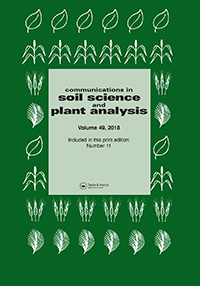View Item
- xmlui.general.dspace_homeCentros e Institutos de InvestigaciónCIRN. Centro de Investigaciones de Recursos NaturalesInstituto de SuelosArtículos científicosxmlui.ArtifactBrowser.ItemViewer.trail
- DSpace Home
- Centros e Institutos de Investigación
- CIRN. Centro de Investigaciones de Recursos Naturales
- Instituto de Suelos
- Artículos científicos
- View Item
Estimating Net Primary Productivity and Carbon Inputs by Soybean Crops in Argentina
Abstract
Monitoring crop net primary productivity (NPP) and its proportion returned to soil in the form of carbon (C) input is vital to better understand the ecological responses to environmental and anthropogenic changes. However, quantification of NPP and C inputs from cropping systems at a regional scale is challenging due to the temporal and spatial variability of soils, climate, and management practices. The aim of this study was to estimate (i) the NPP from
[ver mas...]
Monitoring crop net primary productivity (NPP) and its proportion returned to soil in the form of carbon (C) input is vital to better understand the ecological responses to environmental and anthropogenic changes. However, quantification of NPP and C inputs from cropping systems at a regional scale is challenging due to the temporal and spatial variability of soils, climate, and management practices. The aim of this study was to estimate (i) the NPP from soybean crop [Glycine max (L.) Merr.] and (ii) the C inputs from soybean residues into soils of the Pampas and Extra-Pampas regions of Argentina between 1993 and 2005 using a simple approach based on the crop yield census records, a C budget equation, and crop-specific conversion factors at regional scale. Soybean NPP (t ha−1 year−1) at a regional scale was estimated by grain yields and harvested areas reported in the long-term (1993–2005) National database for several districts within each province. The mean annual soybean NPP in the Pampas was 0.3 t ha−1 higher (P < 0.05) than in the Extra-Pampas, resulting in a higher C input from soybean residues of 0.4 t ha−1 year−1 in the Pampas region. Due to improved cultivars and higher nutrient inputs in the Pampas region, the mean NPP and C inputs increased by about 25% from 1999 to 2005. Crop NPP and C inputs from residues into soils play a major role in C dynamics and should be considered for further studies at different scales to understand soil organic C modifications through agricultural changes.
[Cerrar]

Author
Muschietti Piana, Maria del Pilar;
Civeira, Gabriela;
Fuente
Communications in soil science and plant analysis 48 (10) : 1105–1113. (2017)
Date
2017
ISSN
0010-3624
1532-2416
1532-2416
Formato
pdf
Tipo de documento
artículo
Palabras Claves
Derechos de acceso
Restringido
 Excepto donde se diga explicitamente, este item se publica bajo la siguiente descripción: Creative Commons Attribution-NonCommercial-ShareAlike 2.5 Unported (CC BY-NC-SA 2.5)
Excepto donde se diga explicitamente, este item se publica bajo la siguiente descripción: Creative Commons Attribution-NonCommercial-ShareAlike 2.5 Unported (CC BY-NC-SA 2.5)

